Strategic Management Analysis of Google's Business and Innovation
VerifiedAdded on 2022/12/27
|19
|6237
|64
Report
AI Summary
This report provides a strategic management analysis of Google, examining its business model and innovation strategy within the context of its macro and micro environments. It begins with an introduction outlining the company's background and objectives, followed by an analysis of the macro environment, including key trends in the online search industry and a PESTLE analysis to identify political, economic, social, technological, environmental, and legal factors impacting Google's strategies. The report then delves into the micro-environment using Porter's Five Forces model to assess competitive rivalry, buyer power, supplier power, the threat of substitutes, and the threat of new entrants. Further analysis includes the value capture model to understand the factors impacting the company's success. The main body explores Google's business and innovation strategies, competitive success factors, and appraises the organization's strategic situation, leading to a conclusion summarizing the findings and key takeaways. The report is based on various case studies and aims to provide insights into the factors that have propelled Google to the forefront of the internet search industry.

International Strategic
Management
1
Management
1
Paraphrase This Document
Need a fresh take? Get an instant paraphrase of this document with our AI Paraphraser
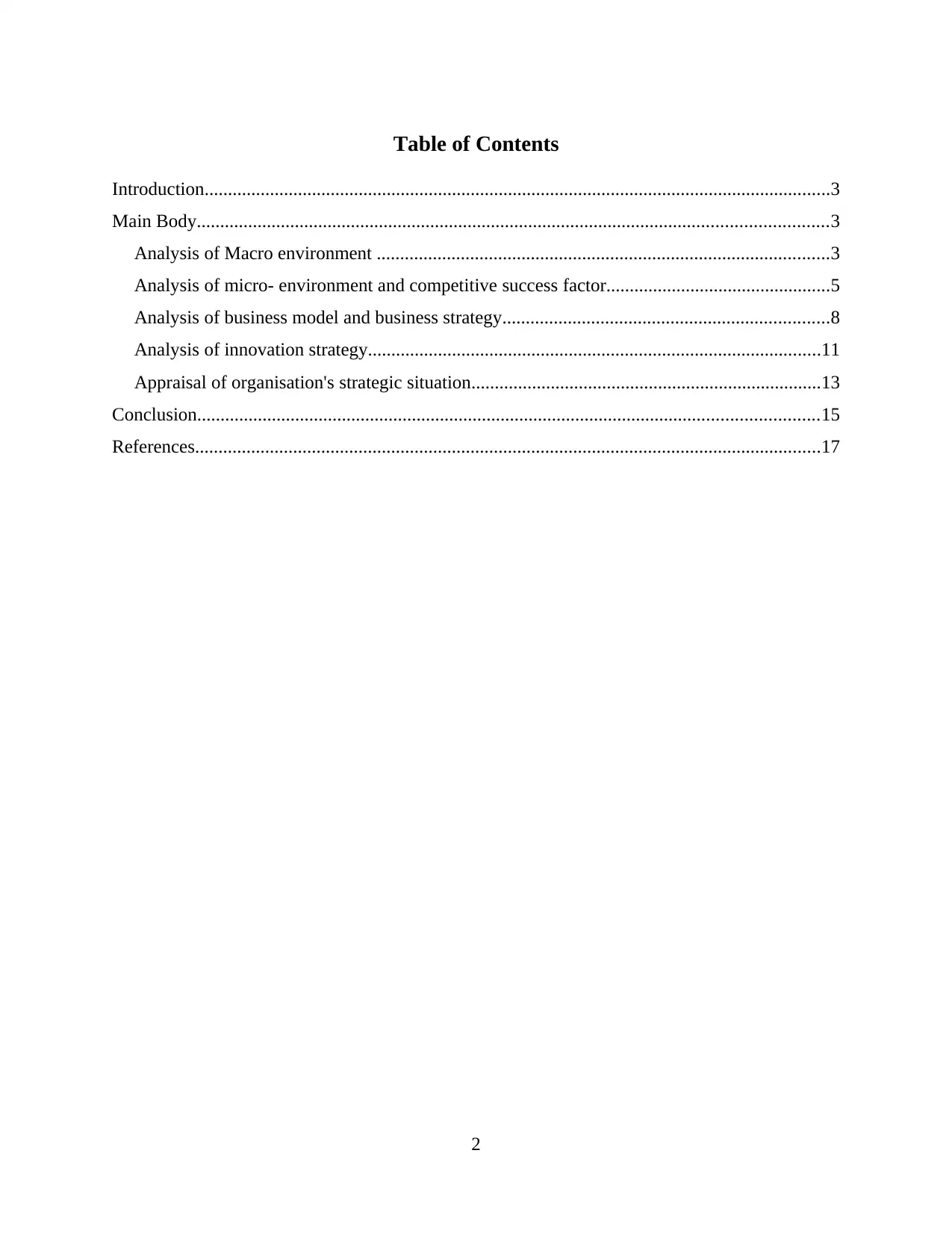
Table of Contents
Introduction......................................................................................................................................3
Main Body.......................................................................................................................................3
Analysis of Macro environment .................................................................................................3
Analysis of micro- environment and competitive success factor................................................5
Analysis of business model and business strategy......................................................................8
Analysis of innovation strategy.................................................................................................11
Appraisal of organisation's strategic situation...........................................................................13
Conclusion.....................................................................................................................................15
References......................................................................................................................................17
2
Introduction......................................................................................................................................3
Main Body.......................................................................................................................................3
Analysis of Macro environment .................................................................................................3
Analysis of micro- environment and competitive success factor................................................5
Analysis of business model and business strategy......................................................................8
Analysis of innovation strategy.................................................................................................11
Appraisal of organisation's strategic situation...........................................................................13
Conclusion.....................................................................................................................................15
References......................................................................................................................................17
2
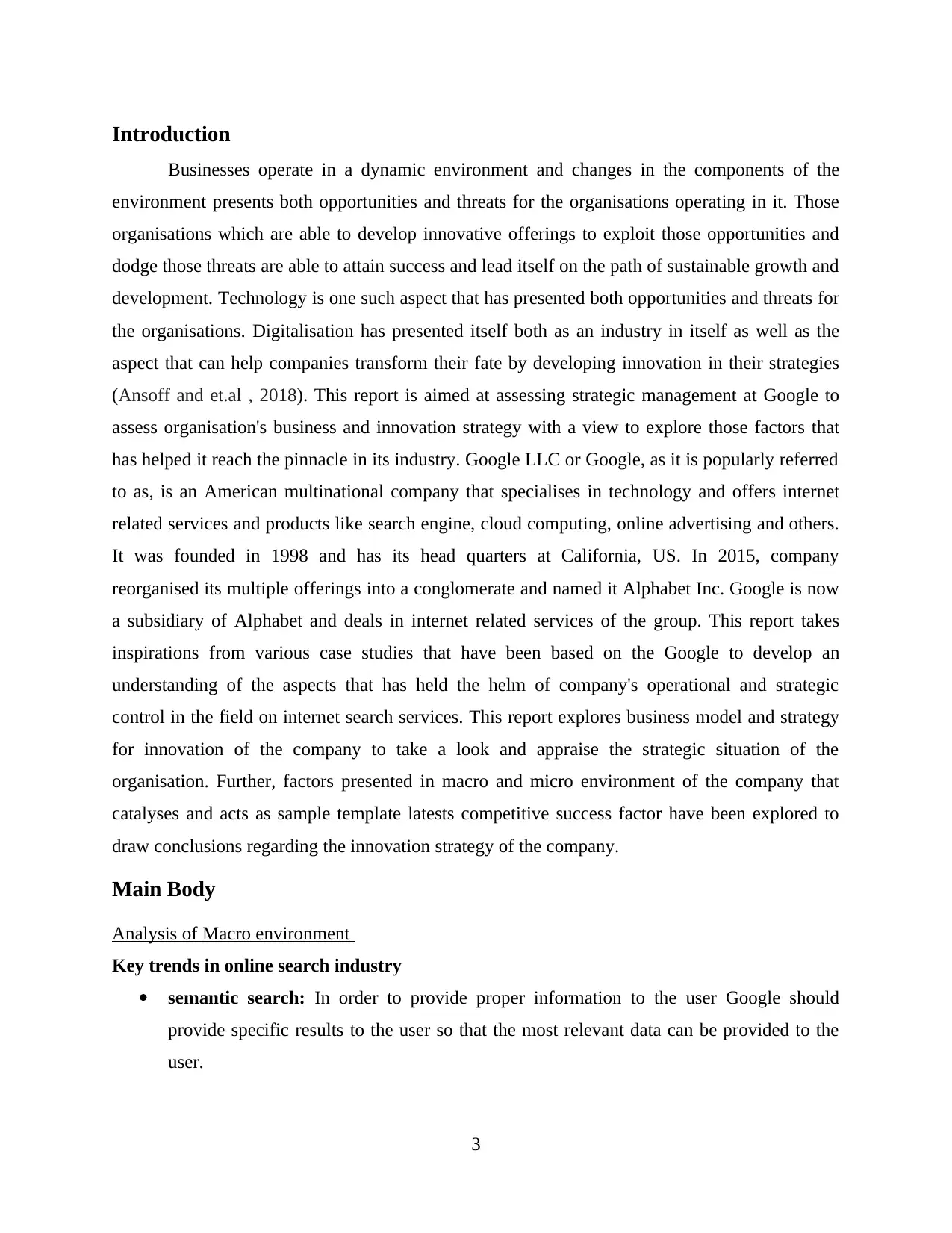
Introduction
Businesses operate in a dynamic environment and changes in the components of the
environment presents both opportunities and threats for the organisations operating in it. Those
organisations which are able to develop innovative offerings to exploit those opportunities and
dodge those threats are able to attain success and lead itself on the path of sustainable growth and
development. Technology is one such aspect that has presented both opportunities and threats for
the organisations. Digitalisation has presented itself both as an industry in itself as well as the
aspect that can help companies transform their fate by developing innovation in their strategies
(Ansoff and et.al , 2018). This report is aimed at assessing strategic management at Google to
assess organisation's business and innovation strategy with a view to explore those factors that
has helped it reach the pinnacle in its industry. Google LLC or Google, as it is popularly referred
to as, is an American multinational company that specialises in technology and offers internet
related services and products like search engine, cloud computing, online advertising and others.
It was founded in 1998 and has its head quarters at California, US. In 2015, company
reorganised its multiple offerings into a conglomerate and named it Alphabet Inc. Google is now
a subsidiary of Alphabet and deals in internet related services of the group. This report takes
inspirations from various case studies that have been based on the Google to develop an
understanding of the aspects that has held the helm of company's operational and strategic
control in the field on internet search services. This report explores business model and strategy
for innovation of the company to take a look and appraise the strategic situation of the
organisation. Further, factors presented in macro and micro environment of the company that
catalyses and acts as sample template latests competitive success factor have been explored to
draw conclusions regarding the innovation strategy of the company.
Main Body
Analysis of Macro environment
Key trends in online search industry
semantic search: In order to provide proper information to the user Google should
provide specific results to the user so that the most relevant data can be provided to the
user.
3
Businesses operate in a dynamic environment and changes in the components of the
environment presents both opportunities and threats for the organisations operating in it. Those
organisations which are able to develop innovative offerings to exploit those opportunities and
dodge those threats are able to attain success and lead itself on the path of sustainable growth and
development. Technology is one such aspect that has presented both opportunities and threats for
the organisations. Digitalisation has presented itself both as an industry in itself as well as the
aspect that can help companies transform their fate by developing innovation in their strategies
(Ansoff and et.al , 2018). This report is aimed at assessing strategic management at Google to
assess organisation's business and innovation strategy with a view to explore those factors that
has helped it reach the pinnacle in its industry. Google LLC or Google, as it is popularly referred
to as, is an American multinational company that specialises in technology and offers internet
related services and products like search engine, cloud computing, online advertising and others.
It was founded in 1998 and has its head quarters at California, US. In 2015, company
reorganised its multiple offerings into a conglomerate and named it Alphabet Inc. Google is now
a subsidiary of Alphabet and deals in internet related services of the group. This report takes
inspirations from various case studies that have been based on the Google to develop an
understanding of the aspects that has held the helm of company's operational and strategic
control in the field on internet search services. This report explores business model and strategy
for innovation of the company to take a look and appraise the strategic situation of the
organisation. Further, factors presented in macro and micro environment of the company that
catalyses and acts as sample template latests competitive success factor have been explored to
draw conclusions regarding the innovation strategy of the company.
Main Body
Analysis of Macro environment
Key trends in online search industry
semantic search: In order to provide proper information to the user Google should
provide specific results to the user so that the most relevant data can be provided to the
user.
3
⊘ This is a preview!⊘
Do you want full access?
Subscribe today to unlock all pages.

Trusted by 1+ million students worldwide
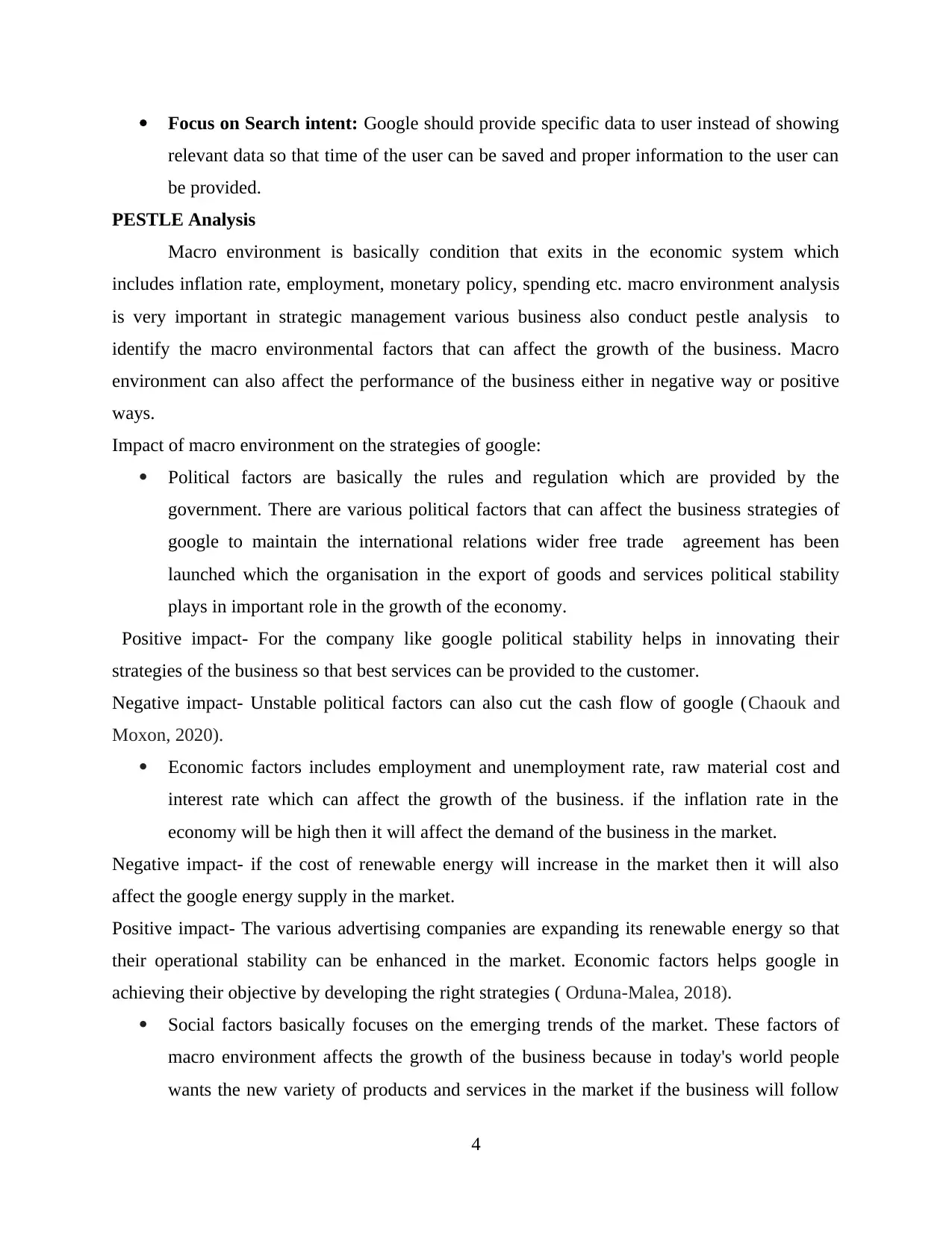
Focus on Search intent: Google should provide specific data to user instead of showing
relevant data so that time of the user can be saved and proper information to the user can
be provided.
PESTLE Analysis
Macro environment is basically condition that exits in the economic system which
includes inflation rate, employment, monetary policy, spending etc. macro environment analysis
is very important in strategic management various business also conduct pestle analysis to
identify the macro environmental factors that can affect the growth of the business. Macro
environment can also affect the performance of the business either in negative way or positive
ways.
Impact of macro environment on the strategies of google:
Political factors are basically the rules and regulation which are provided by the
government. There are various political factors that can affect the business strategies of
google to maintain the international relations wider free trade agreement has been
launched which the organisation in the export of goods and services political stability
plays in important role in the growth of the economy.
Positive impact- For the company like google political stability helps in innovating their
strategies of the business so that best services can be provided to the customer.
Negative impact- Unstable political factors can also cut the cash flow of google (Chaouk and
Moxon, 2020).
Economic factors includes employment and unemployment rate, raw material cost and
interest rate which can affect the growth of the business. if the inflation rate in the
economy will be high then it will affect the demand of the business in the market.
Negative impact- if the cost of renewable energy will increase in the market then it will also
affect the google energy supply in the market.
Positive impact- The various advertising companies are expanding its renewable energy so that
their operational stability can be enhanced in the market. Economic factors helps google in
achieving their objective by developing the right strategies ( Orduna-Malea, 2018).
Social factors basically focuses on the emerging trends of the market. These factors of
macro environment affects the growth of the business because in today's world people
wants the new variety of products and services in the market if the business will follow
4
relevant data so that time of the user can be saved and proper information to the user can
be provided.
PESTLE Analysis
Macro environment is basically condition that exits in the economic system which
includes inflation rate, employment, monetary policy, spending etc. macro environment analysis
is very important in strategic management various business also conduct pestle analysis to
identify the macro environmental factors that can affect the growth of the business. Macro
environment can also affect the performance of the business either in negative way or positive
ways.
Impact of macro environment on the strategies of google:
Political factors are basically the rules and regulation which are provided by the
government. There are various political factors that can affect the business strategies of
google to maintain the international relations wider free trade agreement has been
launched which the organisation in the export of goods and services political stability
plays in important role in the growth of the economy.
Positive impact- For the company like google political stability helps in innovating their
strategies of the business so that best services can be provided to the customer.
Negative impact- Unstable political factors can also cut the cash flow of google (Chaouk and
Moxon, 2020).
Economic factors includes employment and unemployment rate, raw material cost and
interest rate which can affect the growth of the business. if the inflation rate in the
economy will be high then it will affect the demand of the business in the market.
Negative impact- if the cost of renewable energy will increase in the market then it will also
affect the google energy supply in the market.
Positive impact- The various advertising companies are expanding its renewable energy so that
their operational stability can be enhanced in the market. Economic factors helps google in
achieving their objective by developing the right strategies ( Orduna-Malea, 2018).
Social factors basically focuses on the emerging trends of the market. These factors of
macro environment affects the growth of the business because in today's world people
wants the new variety of products and services in the market if the business will follow
4
Paraphrase This Document
Need a fresh take? Get an instant paraphrase of this document with our AI Paraphraser
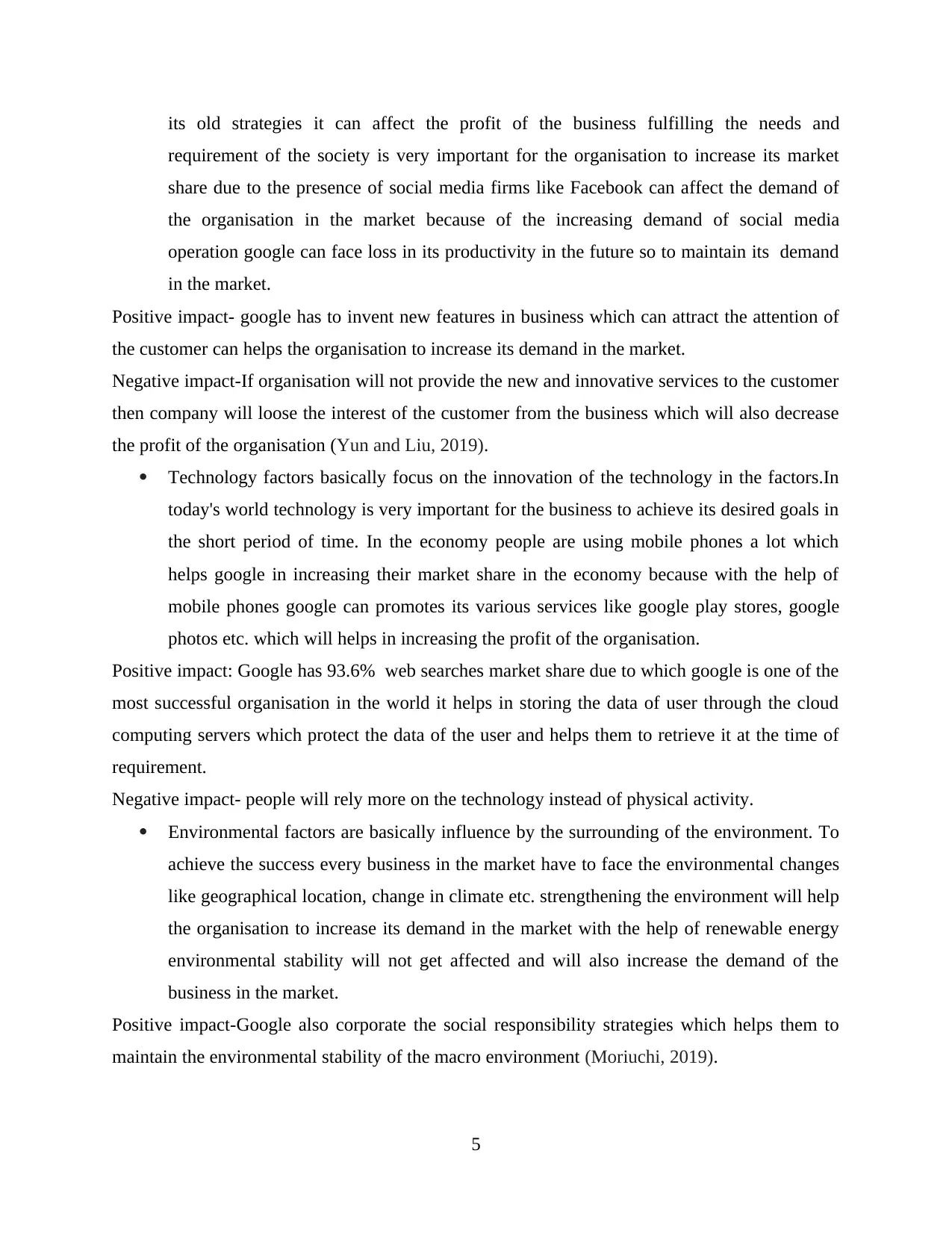
its old strategies it can affect the profit of the business fulfilling the needs and
requirement of the society is very important for the organisation to increase its market
share due to the presence of social media firms like Facebook can affect the demand of
the organisation in the market because of the increasing demand of social media
operation google can face loss in its productivity in the future so to maintain its demand
in the market.
Positive impact- google has to invent new features in business which can attract the attention of
the customer can helps the organisation to increase its demand in the market.
Negative impact-If organisation will not provide the new and innovative services to the customer
then company will loose the interest of the customer from the business which will also decrease
the profit of the organisation (Yun and Liu, 2019).
Technology factors basically focus on the innovation of the technology in the factors.In
today's world technology is very important for the business to achieve its desired goals in
the short period of time. In the economy people are using mobile phones a lot which
helps google in increasing their market share in the economy because with the help of
mobile phones google can promotes its various services like google play stores, google
photos etc. which will helps in increasing the profit of the organisation.
Positive impact: Google has 93.6% web searches market share due to which google is one of the
most successful organisation in the world it helps in storing the data of user through the cloud
computing servers which protect the data of the user and helps them to retrieve it at the time of
requirement.
Negative impact- people will rely more on the technology instead of physical activity.
Environmental factors are basically influence by the surrounding of the environment. To
achieve the success every business in the market have to face the environmental changes
like geographical location, change in climate etc. strengthening the environment will help
the organisation to increase its demand in the market with the help of renewable energy
environmental stability will not get affected and will also increase the demand of the
business in the market.
Positive impact-Google also corporate the social responsibility strategies which helps them to
maintain the environmental stability of the macro environment (Moriuchi, 2019).
5
requirement of the society is very important for the organisation to increase its market
share due to the presence of social media firms like Facebook can affect the demand of
the organisation in the market because of the increasing demand of social media
operation google can face loss in its productivity in the future so to maintain its demand
in the market.
Positive impact- google has to invent new features in business which can attract the attention of
the customer can helps the organisation to increase its demand in the market.
Negative impact-If organisation will not provide the new and innovative services to the customer
then company will loose the interest of the customer from the business which will also decrease
the profit of the organisation (Yun and Liu, 2019).
Technology factors basically focus on the innovation of the technology in the factors.In
today's world technology is very important for the business to achieve its desired goals in
the short period of time. In the economy people are using mobile phones a lot which
helps google in increasing their market share in the economy because with the help of
mobile phones google can promotes its various services like google play stores, google
photos etc. which will helps in increasing the profit of the organisation.
Positive impact: Google has 93.6% web searches market share due to which google is one of the
most successful organisation in the world it helps in storing the data of user through the cloud
computing servers which protect the data of the user and helps them to retrieve it at the time of
requirement.
Negative impact- people will rely more on the technology instead of physical activity.
Environmental factors are basically influence by the surrounding of the environment. To
achieve the success every business in the market have to face the environmental changes
like geographical location, change in climate etc. strengthening the environment will help
the organisation to increase its demand in the market with the help of renewable energy
environmental stability will not get affected and will also increase the demand of the
business in the market.
Positive impact-Google also corporate the social responsibility strategies which helps them to
maintain the environmental stability of the macro environment (Moriuchi, 2019).
5
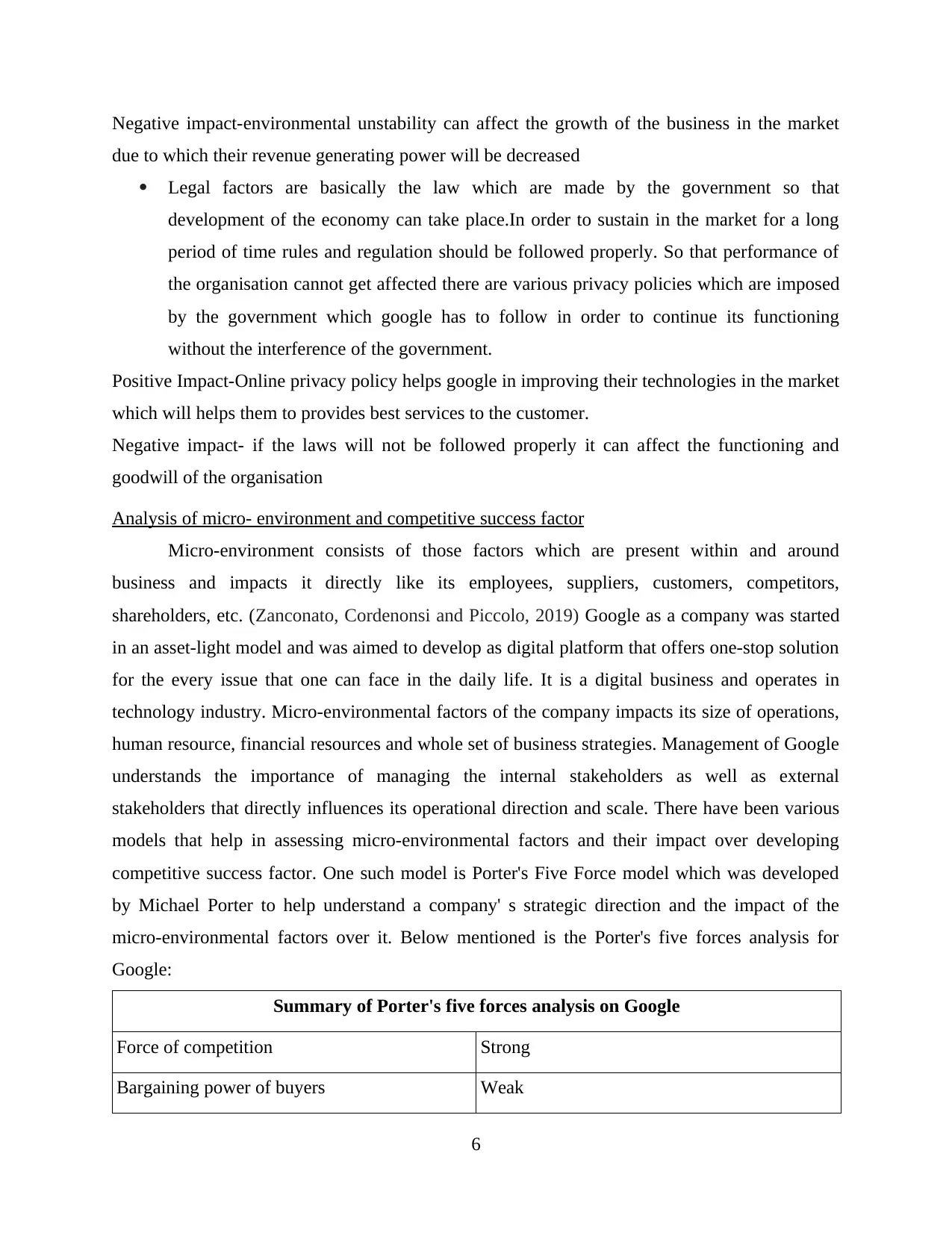
Negative impact-environmental unstability can affect the growth of the business in the market
due to which their revenue generating power will be decreased
Legal factors are basically the law which are made by the government so that
development of the economy can take place.In order to sustain in the market for a long
period of time rules and regulation should be followed properly. So that performance of
the organisation cannot get affected there are various privacy policies which are imposed
by the government which google has to follow in order to continue its functioning
without the interference of the government.
Positive Impact-Online privacy policy helps google in improving their technologies in the market
which will helps them to provides best services to the customer.
Negative impact- if the laws will not be followed properly it can affect the functioning and
goodwill of the organisation
Analysis of micro- environment and competitive success factor
Micro-environment consists of those factors which are present within and around
business and impacts it directly like its employees, suppliers, customers, competitors,
shareholders, etc. (Zanconato, Cordenonsi and Piccolo, 2019) Google as a company was started
in an asset-light model and was aimed to develop as digital platform that offers one-stop solution
for the every issue that one can face in the daily life. It is a digital business and operates in
technology industry. Micro-environmental factors of the company impacts its size of operations,
human resource, financial resources and whole set of business strategies. Management of Google
understands the importance of managing the internal stakeholders as well as external
stakeholders that directly influences its operational direction and scale. There have been various
models that help in assessing micro-environmental factors and their impact over developing
competitive success factor. One such model is Porter's Five Force model which was developed
by Michael Porter to help understand a company' s strategic direction and the impact of the
micro-environmental factors over it. Below mentioned is the Porter's five forces analysis for
Google:
Summary of Porter's five forces analysis on Google
Force of competition Strong
Bargaining power of buyers Weak
6
due to which their revenue generating power will be decreased
Legal factors are basically the law which are made by the government so that
development of the economy can take place.In order to sustain in the market for a long
period of time rules and regulation should be followed properly. So that performance of
the organisation cannot get affected there are various privacy policies which are imposed
by the government which google has to follow in order to continue its functioning
without the interference of the government.
Positive Impact-Online privacy policy helps google in improving their technologies in the market
which will helps them to provides best services to the customer.
Negative impact- if the laws will not be followed properly it can affect the functioning and
goodwill of the organisation
Analysis of micro- environment and competitive success factor
Micro-environment consists of those factors which are present within and around
business and impacts it directly like its employees, suppliers, customers, competitors,
shareholders, etc. (Zanconato, Cordenonsi and Piccolo, 2019) Google as a company was started
in an asset-light model and was aimed to develop as digital platform that offers one-stop solution
for the every issue that one can face in the daily life. It is a digital business and operates in
technology industry. Micro-environmental factors of the company impacts its size of operations,
human resource, financial resources and whole set of business strategies. Management of Google
understands the importance of managing the internal stakeholders as well as external
stakeholders that directly influences its operational direction and scale. There have been various
models that help in assessing micro-environmental factors and their impact over developing
competitive success factor. One such model is Porter's Five Force model which was developed
by Michael Porter to help understand a company' s strategic direction and the impact of the
micro-environmental factors over it. Below mentioned is the Porter's five forces analysis for
Google:
Summary of Porter's five forces analysis on Google
Force of competition Strong
Bargaining power of buyers Weak
6
⊘ This is a preview!⊘
Do you want full access?
Subscribe today to unlock all pages.

Trusted by 1+ million students worldwide
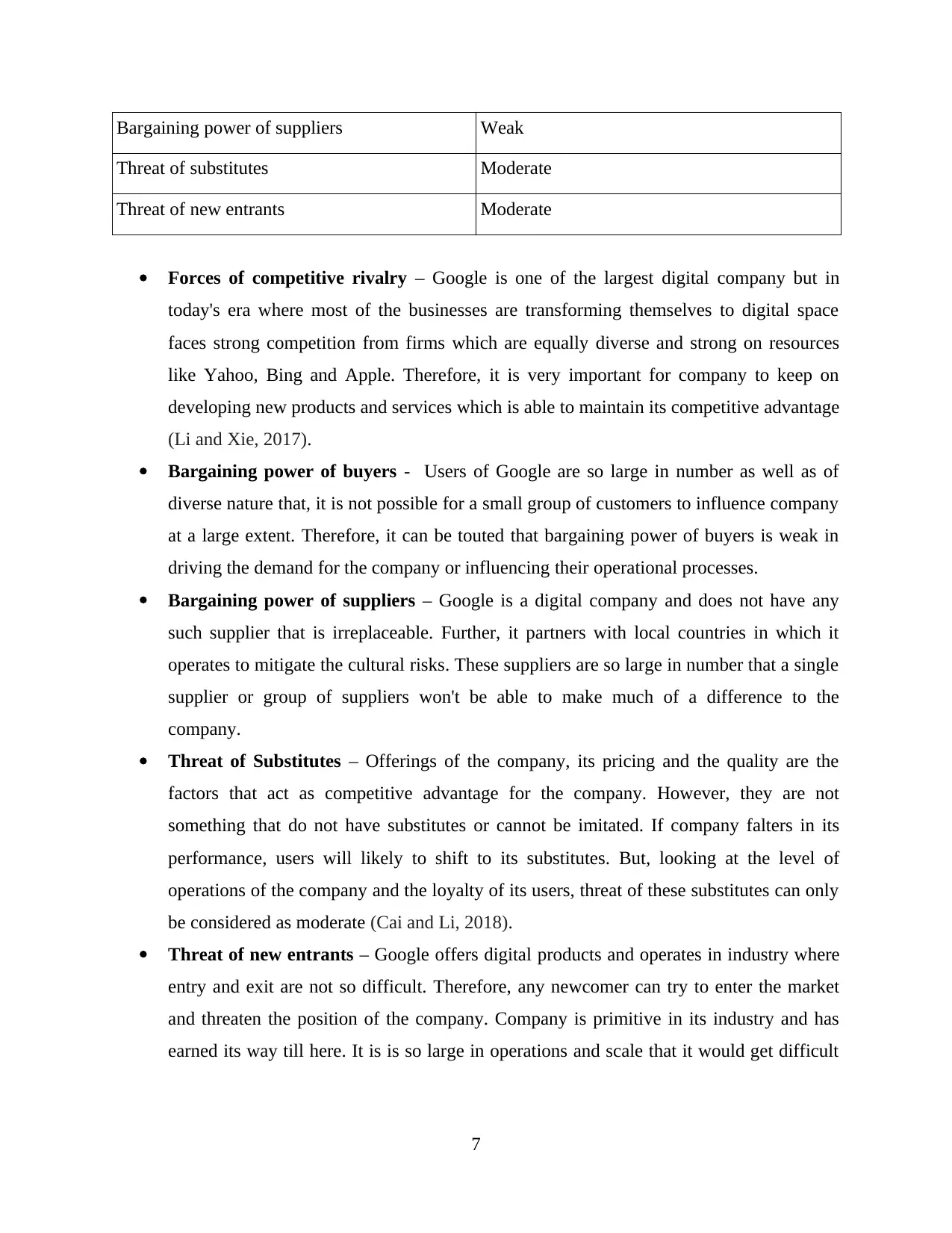
Bargaining power of suppliers Weak
Threat of substitutes Moderate
Threat of new entrants Moderate
Forces of competitive rivalry – Google is one of the largest digital company but in
today's era where most of the businesses are transforming themselves to digital space
faces strong competition from firms which are equally diverse and strong on resources
like Yahoo, Bing and Apple. Therefore, it is very important for company to keep on
developing new products and services which is able to maintain its competitive advantage
(Li and Xie, 2017).
Bargaining power of buyers - Users of Google are so large in number as well as of
diverse nature that, it is not possible for a small group of customers to influence company
at a large extent. Therefore, it can be touted that bargaining power of buyers is weak in
driving the demand for the company or influencing their operational processes.
Bargaining power of suppliers – Google is a digital company and does not have any
such supplier that is irreplaceable. Further, it partners with local countries in which it
operates to mitigate the cultural risks. These suppliers are so large in number that a single
supplier or group of suppliers won't be able to make much of a difference to the
company.
Threat of Substitutes – Offerings of the company, its pricing and the quality are the
factors that act as competitive advantage for the company. However, they are not
something that do not have substitutes or cannot be imitated. If company falters in its
performance, users will likely to shift to its substitutes. But, looking at the level of
operations of the company and the loyalty of its users, threat of these substitutes can only
be considered as moderate (Cai and Li, 2018).
Threat of new entrants – Google offers digital products and operates in industry where
entry and exit are not so difficult. Therefore, any newcomer can try to enter the market
and threaten the position of the company. Company is primitive in its industry and has
earned its way till here. It is is so large in operations and scale that it would get difficult
7
Threat of substitutes Moderate
Threat of new entrants Moderate
Forces of competitive rivalry – Google is one of the largest digital company but in
today's era where most of the businesses are transforming themselves to digital space
faces strong competition from firms which are equally diverse and strong on resources
like Yahoo, Bing and Apple. Therefore, it is very important for company to keep on
developing new products and services which is able to maintain its competitive advantage
(Li and Xie, 2017).
Bargaining power of buyers - Users of Google are so large in number as well as of
diverse nature that, it is not possible for a small group of customers to influence company
at a large extent. Therefore, it can be touted that bargaining power of buyers is weak in
driving the demand for the company or influencing their operational processes.
Bargaining power of suppliers – Google is a digital company and does not have any
such supplier that is irreplaceable. Further, it partners with local countries in which it
operates to mitigate the cultural risks. These suppliers are so large in number that a single
supplier or group of suppliers won't be able to make much of a difference to the
company.
Threat of Substitutes – Offerings of the company, its pricing and the quality are the
factors that act as competitive advantage for the company. However, they are not
something that do not have substitutes or cannot be imitated. If company falters in its
performance, users will likely to shift to its substitutes. But, looking at the level of
operations of the company and the loyalty of its users, threat of these substitutes can only
be considered as moderate (Cai and Li, 2018).
Threat of new entrants – Google offers digital products and operates in industry where
entry and exit are not so difficult. Therefore, any newcomer can try to enter the market
and threaten the position of the company. Company is primitive in its industry and has
earned its way till here. It is is so large in operations and scale that it would get difficult
7
Paraphrase This Document
Need a fresh take? Get an instant paraphrase of this document with our AI Paraphraser
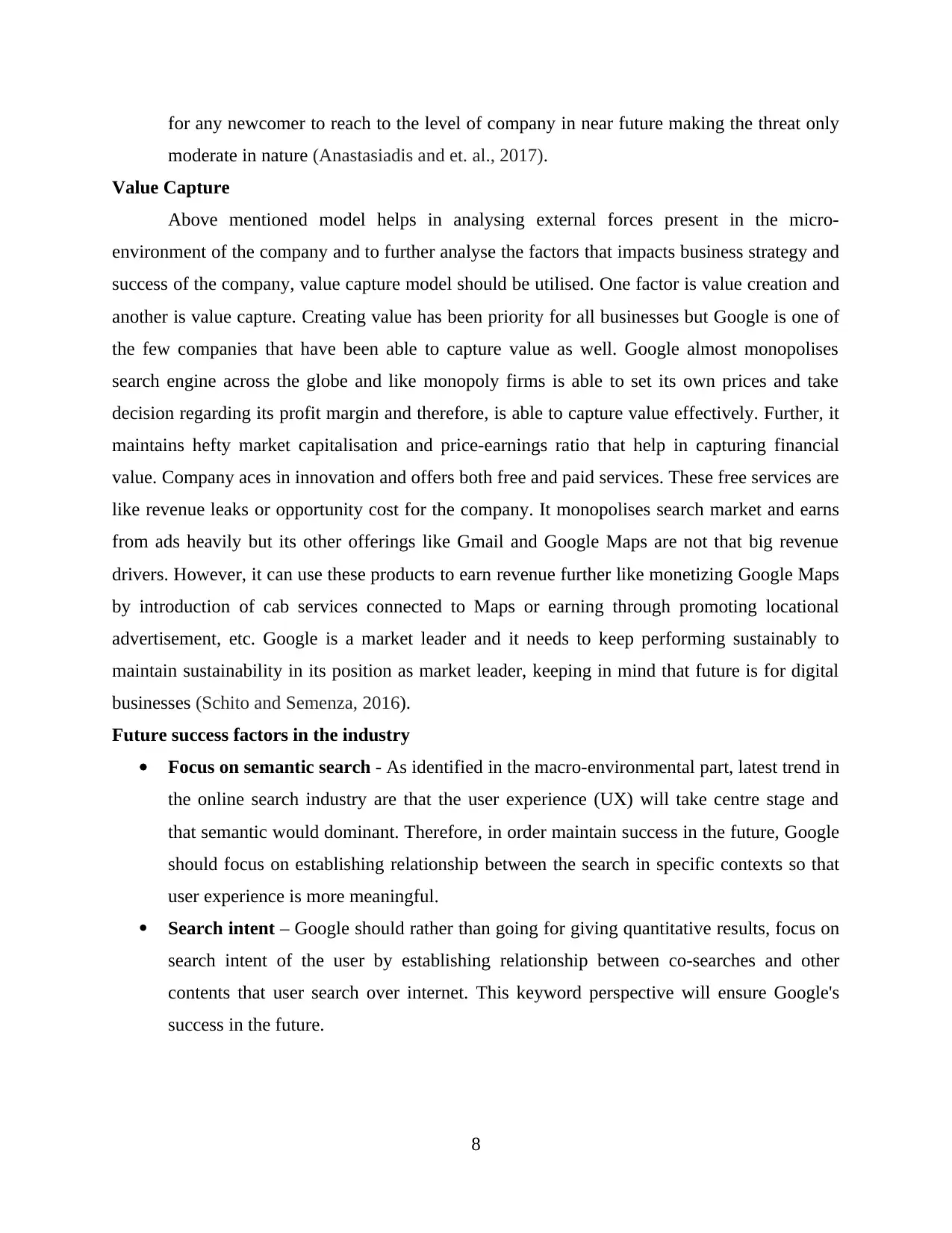
for any newcomer to reach to the level of company in near future making the threat only
moderate in nature (Anastasiadis and et. al., 2017).
Value Capture
Above mentioned model helps in analysing external forces present in the micro-
environment of the company and to further analyse the factors that impacts business strategy and
success of the company, value capture model should be utilised. One factor is value creation and
another is value capture. Creating value has been priority for all businesses but Google is one of
the few companies that have been able to capture value as well. Google almost monopolises
search engine across the globe and like monopoly firms is able to set its own prices and take
decision regarding its profit margin and therefore, is able to capture value effectively. Further, it
maintains hefty market capitalisation and price-earnings ratio that help in capturing financial
value. Company aces in innovation and offers both free and paid services. These free services are
like revenue leaks or opportunity cost for the company. It monopolises search market and earns
from ads heavily but its other offerings like Gmail and Google Maps are not that big revenue
drivers. However, it can use these products to earn revenue further like monetizing Google Maps
by introduction of cab services connected to Maps or earning through promoting locational
advertisement, etc. Google is a market leader and it needs to keep performing sustainably to
maintain sustainability in its position as market leader, keeping in mind that future is for digital
businesses (Schito and Semenza, 2016).
Future success factors in the industry
Focus on semantic search - As identified in the macro-environmental part, latest trend in
the online search industry are that the user experience (UX) will take centre stage and
that semantic would dominant. Therefore, in order maintain success in the future, Google
should focus on establishing relationship between the search in specific contexts so that
user experience is more meaningful.
Search intent – Google should rather than going for giving quantitative results, focus on
search intent of the user by establishing relationship between co-searches and other
contents that user search over internet. This keyword perspective will ensure Google's
success in the future.
8
moderate in nature (Anastasiadis and et. al., 2017).
Value Capture
Above mentioned model helps in analysing external forces present in the micro-
environment of the company and to further analyse the factors that impacts business strategy and
success of the company, value capture model should be utilised. One factor is value creation and
another is value capture. Creating value has been priority for all businesses but Google is one of
the few companies that have been able to capture value as well. Google almost monopolises
search engine across the globe and like monopoly firms is able to set its own prices and take
decision regarding its profit margin and therefore, is able to capture value effectively. Further, it
maintains hefty market capitalisation and price-earnings ratio that help in capturing financial
value. Company aces in innovation and offers both free and paid services. These free services are
like revenue leaks or opportunity cost for the company. It monopolises search market and earns
from ads heavily but its other offerings like Gmail and Google Maps are not that big revenue
drivers. However, it can use these products to earn revenue further like monetizing Google Maps
by introduction of cab services connected to Maps or earning through promoting locational
advertisement, etc. Google is a market leader and it needs to keep performing sustainably to
maintain sustainability in its position as market leader, keeping in mind that future is for digital
businesses (Schito and Semenza, 2016).
Future success factors in the industry
Focus on semantic search - As identified in the macro-environmental part, latest trend in
the online search industry are that the user experience (UX) will take centre stage and
that semantic would dominant. Therefore, in order maintain success in the future, Google
should focus on establishing relationship between the search in specific contexts so that
user experience is more meaningful.
Search intent – Google should rather than going for giving quantitative results, focus on
search intent of the user by establishing relationship between co-searches and other
contents that user search over internet. This keyword perspective will ensure Google's
success in the future.
8
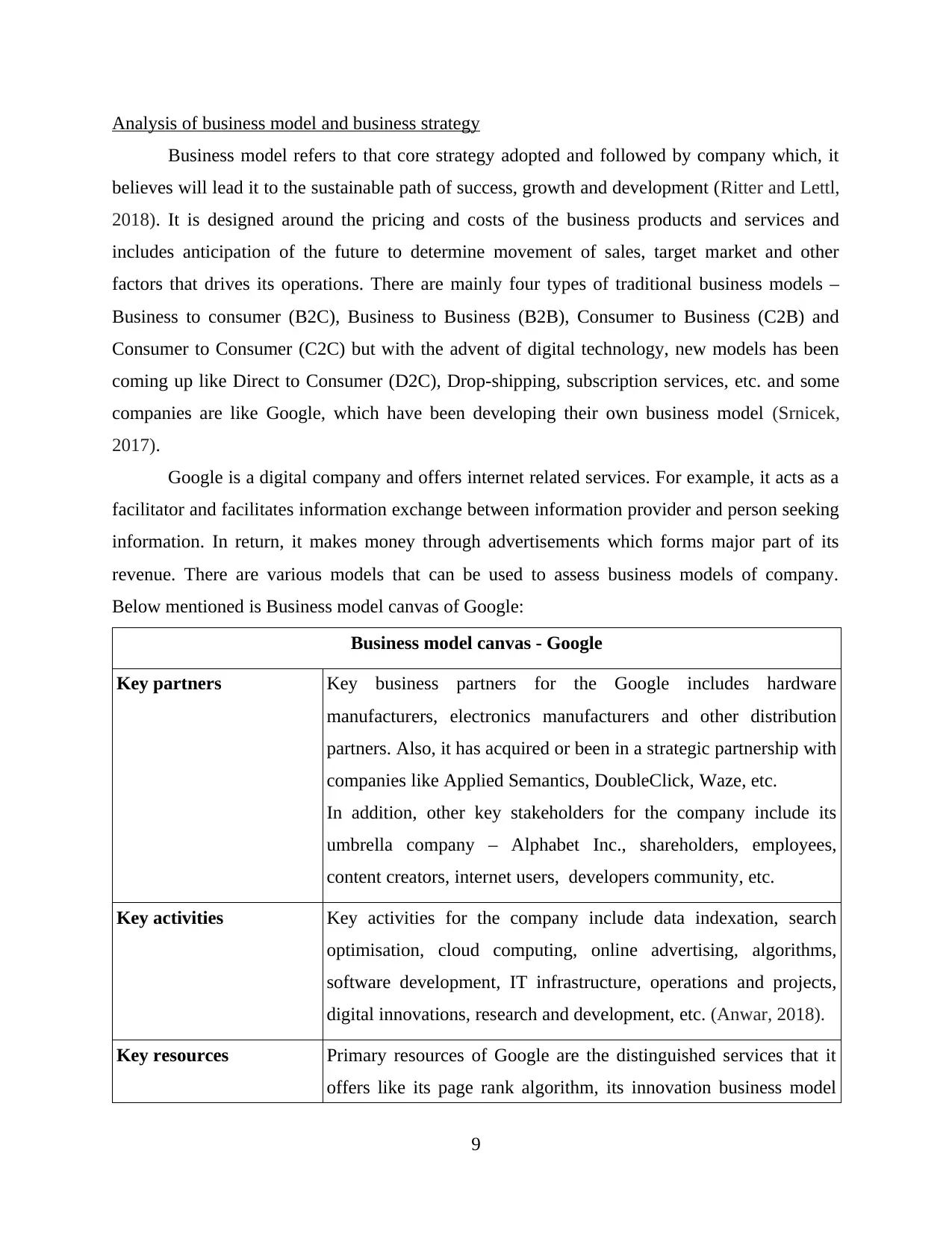
Analysis of business model and business strategy
Business model refers to that core strategy adopted and followed by company which, it
believes will lead it to the sustainable path of success, growth and development (Ritter and Lettl,
2018). It is designed around the pricing and costs of the business products and services and
includes anticipation of the future to determine movement of sales, target market and other
factors that drives its operations. There are mainly four types of traditional business models –
Business to consumer (B2C), Business to Business (B2B), Consumer to Business (C2B) and
Consumer to Consumer (C2C) but with the advent of digital technology, new models has been
coming up like Direct to Consumer (D2C), Drop-shipping, subscription services, etc. and some
companies are like Google, which have been developing their own business model (Srnicek,
2017).
Google is a digital company and offers internet related services. For example, it acts as a
facilitator and facilitates information exchange between information provider and person seeking
information. In return, it makes money through advertisements which forms major part of its
revenue. There are various models that can be used to assess business models of company.
Below mentioned is Business model canvas of Google:
Business model canvas - Google
Key partners Key business partners for the Google includes hardware
manufacturers, electronics manufacturers and other distribution
partners. Also, it has acquired or been in a strategic partnership with
companies like Applied Semantics, DoubleClick, Waze, etc.
In addition, other key stakeholders for the company include its
umbrella company – Alphabet Inc., shareholders, employees,
content creators, internet users, developers community, etc.
Key activities Key activities for the company include data indexation, search
optimisation, cloud computing, online advertising, algorithms,
software development, IT infrastructure, operations and projects,
digital innovations, research and development, etc. (Anwar, 2018).
Key resources Primary resources of Google are the distinguished services that it
offers like its page rank algorithm, its innovation business model
9
Business model refers to that core strategy adopted and followed by company which, it
believes will lead it to the sustainable path of success, growth and development (Ritter and Lettl,
2018). It is designed around the pricing and costs of the business products and services and
includes anticipation of the future to determine movement of sales, target market and other
factors that drives its operations. There are mainly four types of traditional business models –
Business to consumer (B2C), Business to Business (B2B), Consumer to Business (C2B) and
Consumer to Consumer (C2C) but with the advent of digital technology, new models has been
coming up like Direct to Consumer (D2C), Drop-shipping, subscription services, etc. and some
companies are like Google, which have been developing their own business model (Srnicek,
2017).
Google is a digital company and offers internet related services. For example, it acts as a
facilitator and facilitates information exchange between information provider and person seeking
information. In return, it makes money through advertisements which forms major part of its
revenue. There are various models that can be used to assess business models of company.
Below mentioned is Business model canvas of Google:
Business model canvas - Google
Key partners Key business partners for the Google includes hardware
manufacturers, electronics manufacturers and other distribution
partners. Also, it has acquired or been in a strategic partnership with
companies like Applied Semantics, DoubleClick, Waze, etc.
In addition, other key stakeholders for the company include its
umbrella company – Alphabet Inc., shareholders, employees,
content creators, internet users, developers community, etc.
Key activities Key activities for the company include data indexation, search
optimisation, cloud computing, online advertising, algorithms,
software development, IT infrastructure, operations and projects,
digital innovations, research and development, etc. (Anwar, 2018).
Key resources Primary resources of Google are the distinguished services that it
offers like its page rank algorithm, its innovation business model
9
⊘ This is a preview!⊘
Do you want full access?
Subscribe today to unlock all pages.

Trusted by 1+ million students worldwide

and company culture, its intellectual patents, its talented staff and
content developers. Additionally, it has huge financial resource that
supports its infrastructure, platforms and ecosystem to make use of
the another key resource that it possesses i.e. big data.
Value propositions Google has a simplified business structure and targets diversified
products and services to make life simpler and easier i.e. like free
email service, instant messaging and video chat service, language
translation service, navigation and mapping service, etc.
Further, it keeps on researching and innovating its products and
services with the use of advance technologies to facilitate its
customers like its marketplace (Google Play), hosted web-based
apps, content platforms (like photos, music and video organising,
editing and sharing), cloud computing services, virtual reality,
artificial intelligence (Google Assistant), Internet carrier (Google
Fibre)m etc. (Bouncken and Fredrich, 2016)
Cost Structure Primary compositions of its cost structure includes general
operational costs like administrative cost, taxes, etc. and product
and services cost like cost of software development, maintaining
data centres, etc. Further, it incurs huge amount of money every
year in research and development of new technologies and their
application in various parts of the world. To implement those
technologies, it has to further incur legal and lobbying cost.
Revenue Streams Google offers both free and paid products and services to its
customers. Its revenue stream comprises from users like premium
services – advanced email, App Store payments, etc., from
companies – ad revenue, segmentation, licensing, subscription, etc.,
from developers – on enlisting at Play Store, from e-commerce –
Google Shopping, etc. (Keiningham and et.al , 2020)
Customer relationships Google has a strong and committed relationship with its customers.
It has become synonymous for searching something over the
10
content developers. Additionally, it has huge financial resource that
supports its infrastructure, platforms and ecosystem to make use of
the another key resource that it possesses i.e. big data.
Value propositions Google has a simplified business structure and targets diversified
products and services to make life simpler and easier i.e. like free
email service, instant messaging and video chat service, language
translation service, navigation and mapping service, etc.
Further, it keeps on researching and innovating its products and
services with the use of advance technologies to facilitate its
customers like its marketplace (Google Play), hosted web-based
apps, content platforms (like photos, music and video organising,
editing and sharing), cloud computing services, virtual reality,
artificial intelligence (Google Assistant), Internet carrier (Google
Fibre)m etc. (Bouncken and Fredrich, 2016)
Cost Structure Primary compositions of its cost structure includes general
operational costs like administrative cost, taxes, etc. and product
and services cost like cost of software development, maintaining
data centres, etc. Further, it incurs huge amount of money every
year in research and development of new technologies and their
application in various parts of the world. To implement those
technologies, it has to further incur legal and lobbying cost.
Revenue Streams Google offers both free and paid products and services to its
customers. Its revenue stream comprises from users like premium
services – advanced email, App Store payments, etc., from
companies – ad revenue, segmentation, licensing, subscription, etc.,
from developers – on enlisting at Play Store, from e-commerce –
Google Shopping, etc. (Keiningham and et.al , 2020)
Customer relationships Google has a strong and committed relationship with its customers.
It has become synonymous for searching something over the
10
Paraphrase This Document
Need a fresh take? Get an instant paraphrase of this document with our AI Paraphraser
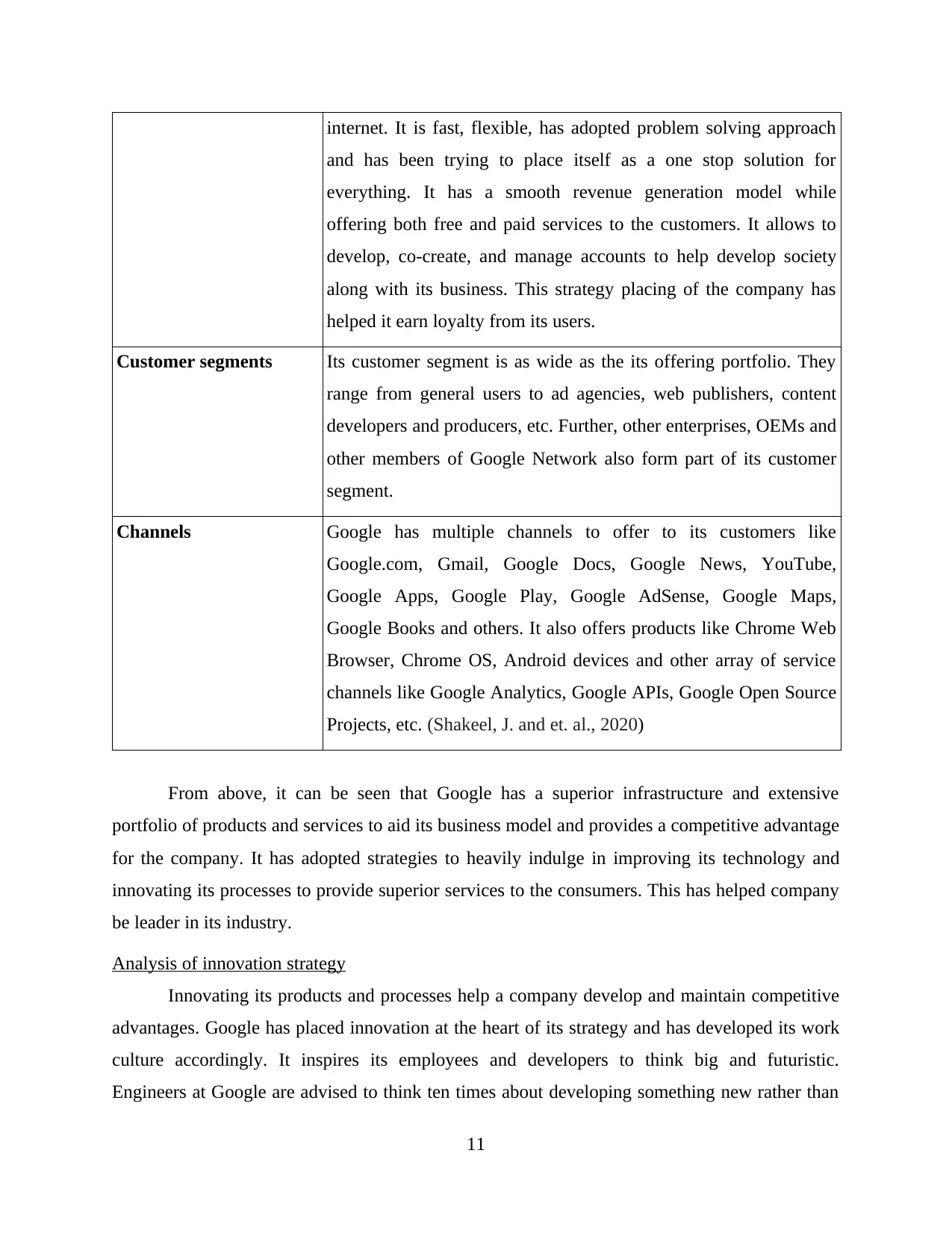
internet. It is fast, flexible, has adopted problem solving approach
and has been trying to place itself as a one stop solution for
everything. It has a smooth revenue generation model while
offering both free and paid services to the customers. It allows to
develop, co-create, and manage accounts to help develop society
along with its business. This strategy placing of the company has
helped it earn loyalty from its users.
Customer segments Its customer segment is as wide as the its offering portfolio. They
range from general users to ad agencies, web publishers, content
developers and producers, etc. Further, other enterprises, OEMs and
other members of Google Network also form part of its customer
segment.
Channels Google has multiple channels to offer to its customers like
Google.com, Gmail, Google Docs, Google News, YouTube,
Google Apps, Google Play, Google AdSense, Google Maps,
Google Books and others. It also offers products like Chrome Web
Browser, Chrome OS, Android devices and other array of service
channels like Google Analytics, Google APIs, Google Open Source
Projects, etc. (Shakeel, J. and et. al., 2020)
From above, it can be seen that Google has a superior infrastructure and extensive
portfolio of products and services to aid its business model and provides a competitive advantage
for the company. It has adopted strategies to heavily indulge in improving its technology and
innovating its processes to provide superior services to the consumers. This has helped company
be leader in its industry.
Analysis of innovation strategy
Innovating its products and processes help a company develop and maintain competitive
advantages. Google has placed innovation at the heart of its strategy and has developed its work
culture accordingly. It inspires its employees and developers to think big and futuristic.
Engineers at Google are advised to think ten times about developing something new rather than
11
and has been trying to place itself as a one stop solution for
everything. It has a smooth revenue generation model while
offering both free and paid services to the customers. It allows to
develop, co-create, and manage accounts to help develop society
along with its business. This strategy placing of the company has
helped it earn loyalty from its users.
Customer segments Its customer segment is as wide as the its offering portfolio. They
range from general users to ad agencies, web publishers, content
developers and producers, etc. Further, other enterprises, OEMs and
other members of Google Network also form part of its customer
segment.
Channels Google has multiple channels to offer to its customers like
Google.com, Gmail, Google Docs, Google News, YouTube,
Google Apps, Google Play, Google AdSense, Google Maps,
Google Books and others. It also offers products like Chrome Web
Browser, Chrome OS, Android devices and other array of service
channels like Google Analytics, Google APIs, Google Open Source
Projects, etc. (Shakeel, J. and et. al., 2020)
From above, it can be seen that Google has a superior infrastructure and extensive
portfolio of products and services to aid its business model and provides a competitive advantage
for the company. It has adopted strategies to heavily indulge in improving its technology and
innovating its processes to provide superior services to the consumers. This has helped company
be leader in its industry.
Analysis of innovation strategy
Innovating its products and processes help a company develop and maintain competitive
advantages. Google has placed innovation at the heart of its strategy and has developed its work
culture accordingly. It inspires its employees and developers to think big and futuristic.
Engineers at Google are advised to think ten times about developing something new rather than
11
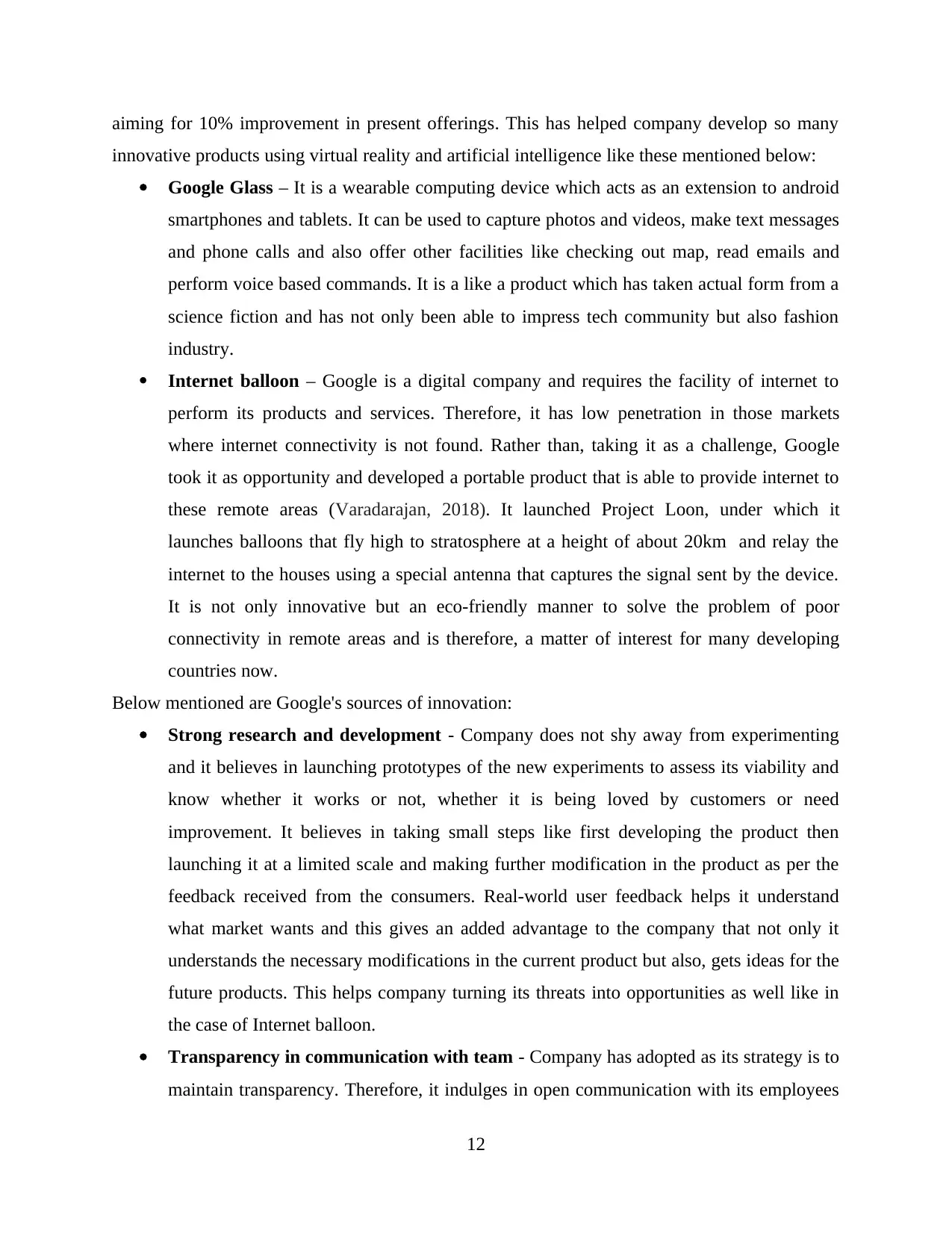
aiming for 10% improvement in present offerings. This has helped company develop so many
innovative products using virtual reality and artificial intelligence like these mentioned below:
Google Glass – It is a wearable computing device which acts as an extension to android
smartphones and tablets. It can be used to capture photos and videos, make text messages
and phone calls and also offer other facilities like checking out map, read emails and
perform voice based commands. It is a like a product which has taken actual form from a
science fiction and has not only been able to impress tech community but also fashion
industry.
Internet balloon – Google is a digital company and requires the facility of internet to
perform its products and services. Therefore, it has low penetration in those markets
where internet connectivity is not found. Rather than, taking it as a challenge, Google
took it as opportunity and developed a portable product that is able to provide internet to
these remote areas (Varadarajan, 2018). It launched Project Loon, under which it
launches balloons that fly high to stratosphere at a height of about 20km and relay the
internet to the houses using a special antenna that captures the signal sent by the device.
It is not only innovative but an eco-friendly manner to solve the problem of poor
connectivity in remote areas and is therefore, a matter of interest for many developing
countries now.
Below mentioned are Google's sources of innovation:
Strong research and development - Company does not shy away from experimenting
and it believes in launching prototypes of the new experiments to assess its viability and
know whether it works or not, whether it is being loved by customers or need
improvement. It believes in taking small steps like first developing the product then
launching it at a limited scale and making further modification in the product as per the
feedback received from the consumers. Real-world user feedback helps it understand
what market wants and this gives an added advantage to the company that not only it
understands the necessary modifications in the current product but also, gets ideas for the
future products. This helps company turning its threats into opportunities as well like in
the case of Internet balloon.
Transparency in communication with team - Company has adopted as its strategy is to
maintain transparency. Therefore, it indulges in open communication with its employees
12
innovative products using virtual reality and artificial intelligence like these mentioned below:
Google Glass – It is a wearable computing device which acts as an extension to android
smartphones and tablets. It can be used to capture photos and videos, make text messages
and phone calls and also offer other facilities like checking out map, read emails and
perform voice based commands. It is a like a product which has taken actual form from a
science fiction and has not only been able to impress tech community but also fashion
industry.
Internet balloon – Google is a digital company and requires the facility of internet to
perform its products and services. Therefore, it has low penetration in those markets
where internet connectivity is not found. Rather than, taking it as a challenge, Google
took it as opportunity and developed a portable product that is able to provide internet to
these remote areas (Varadarajan, 2018). It launched Project Loon, under which it
launches balloons that fly high to stratosphere at a height of about 20km and relay the
internet to the houses using a special antenna that captures the signal sent by the device.
It is not only innovative but an eco-friendly manner to solve the problem of poor
connectivity in remote areas and is therefore, a matter of interest for many developing
countries now.
Below mentioned are Google's sources of innovation:
Strong research and development - Company does not shy away from experimenting
and it believes in launching prototypes of the new experiments to assess its viability and
know whether it works or not, whether it is being loved by customers or need
improvement. It believes in taking small steps like first developing the product then
launching it at a limited scale and making further modification in the product as per the
feedback received from the consumers. Real-world user feedback helps it understand
what market wants and this gives an added advantage to the company that not only it
understands the necessary modifications in the current product but also, gets ideas for the
future products. This helps company turning its threats into opportunities as well like in
the case of Internet balloon.
Transparency in communication with team - Company has adopted as its strategy is to
maintain transparency. Therefore, it indulges in open communication with its employees
12
⊘ This is a preview!⊘
Do you want full access?
Subscribe today to unlock all pages.

Trusted by 1+ million students worldwide
1 out of 19
Related Documents
Your All-in-One AI-Powered Toolkit for Academic Success.
+13062052269
info@desklib.com
Available 24*7 on WhatsApp / Email
![[object Object]](/_next/static/media/star-bottom.7253800d.svg)
Unlock your academic potential
Copyright © 2020–2025 A2Z Services. All Rights Reserved. Developed and managed by ZUCOL.




